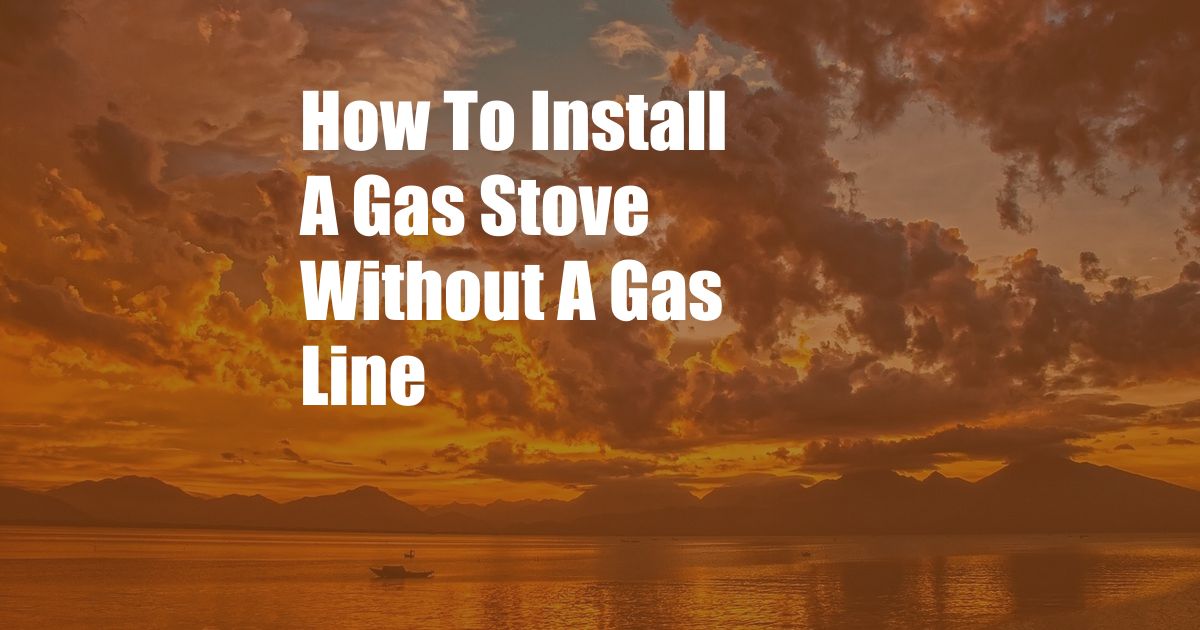
Cooking with Gas: Exploring Alternative Solutions for a Gas Stove Installation
As a seasoned foodie, I’ve witnessed firsthand the culinary magic that a gas stove conjures up. Its responsive flames and precise temperature control elevate any dish to gastronomic heights. However, the absence of a gas line can dampen the dream of home cooks yearning for a gas stove experience. Fear not, for innovative alternatives offer a viable path to ignite the culinary flame.
One such alternative is the propane gas stove, a self-contained cooking appliance that draws fuel from a portable propane tank. This clever solution offers the convenience of gas cooking without the need for a permanent gas line. Whether it’s for a remote cabin, a temporary kitchen setup, or simply a kitchen lacking a gas line, a propane gas stove empowers you with the flexibility to cook with gas.
Unveiling the Propane Gas Stove: A Path to Culinary Independence
The propane gas stove operates on the principle of liquefied petroleum gas (LPG), with propane as its primary component. This highly combustible gas is stored in a portable tank that connects directly to the stove. The stove’s burners ignite the propane, producing a clean and efficient flame perfect for cooking.
Propane gas stoves come in various sizes and configurations, catering to different kitchen needs. From compact single-burner models to full-sized ranges with multiple burners and an oven, there’s a propane gas stove to match every cooking style and kitchen layout. Moreover, their freestanding design allows for easy placement in any kitchen, regardless of the absence of a gas line. The convenience of a propane gas stove extends beyond its portability. Its self-sustaining nature eliminates the need for costly gas line installation, providing a cost-effective solution for those who seek the benefits of gas cooking without the associated expenses.
Expert Tips and Advice for a Smooth Propane Gas Stove Installation
While installing a propane gas stove is relatively straightforward, adhering to safety guidelines and following expert advice ensures a seamless and secure setup. Here are some crucial tips to guide you through the process.
1. **Gas Safety First**: Propane is a highly flammable gas, so handling it with utmost care is paramount. Always ensure proper ventilation when using or storing propane appliances to prevent gas buildup and potential hazards.
2. **Tank Placement**: Position the propane tank in a well-ventilated area outside your home, away from sources of ignition and direct sunlight. Secure the tank upright and level, using a sturdy base or bracket, to prevent accidental tipping or movement.
3. **Connecting the Stove**: Using a certified gas hose specifically designed for propane, connect the tank to the stove. Double-check all connections to eliminate any gas leaks, using a soapy water solution to identify any bubbles forming at the joints.
4. **Igniting the Burner**: Before igniting the burners, open a window or door to ensure proper ventilation. Follow the manufacturer’s instructions for lighting the stove, and never attempt to light the burners if you detect a gas leak.
FAQs: Unraveling Common Queries on Propane Gas Stoves
To address common concerns and provide further clarity, here’s a section dedicated to frequently asked questions about propane gas stoves.
- Q: Is it safe to use a propane gas stove indoors?
A: Yes, propane gas stoves are designed for both indoor and outdoor use, provided adequate ventilation is maintained. Ensure the room has proper air circulation, especially when using the stove for extended periods.
- Q: How long does a propane tank last?
A: The lifespan of a propane tank depends on various factors, including the size of the tank, the frequency of use, and the type of appliances connected to it. Typically, a 20-pound propane tank can last anywhere from a few weeks to several months.
- Q: Can I convert my natural gas stove to propane?
A: While it’s technically possible, converting a natural gas stove to propane is not recommended. The process requires specialized knowledge and expertise to ensure safe and efficient operation. It’s advisable to purchase a propane gas stove specifically designed for propane use.
Conclusion: Embracing Culinary Versatility with Propane Gas Stoves
In the realm of home cooking, few things rival the versatility and precision of a gas stove. However, the absence of a gas line need not extinguish your culinary aspirations. Propane gas stoves offer a viable alternative, providing the same cooking experience with the added advantage of portability and cost-effectiveness. By following the expert tips and guidelines outlined above, you can confidently install and enjoy the benefits of a propane gas stove, unlocking a world of culinary possibilities in your kitchen.
Are you ready to ignite your culinary journey with a propane gas stove? Share your thoughts and questions in the comments below, and let’s explore the exciting realm of gas cooking together!